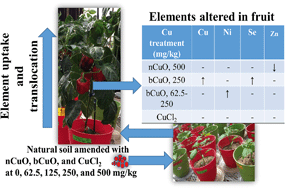当前位置:
X-MOL 学术
›
Environ. Sci.: Nano
›
论文详情
Our official English website, www.x-mol.net, welcomes your feedback! (Note: you will need to create a separate account there.)
Impacts of copper oxide nanoparticles on bell pepper (Capsicum annum L.) plants: a full life cycle study†
Environmental Science: Nano ( IF 7.3 ) Pub Date : 2017-10-19 00:00:00 , DOI: 10.1039/c7en00697g Swati Rawat 1, 2, 3, 4, 5 , Venkata L. R. Pullagurala 1, 2, 3, 4, 5 , Mariana Hernandez-Molina 2, 3, 4, 6, 7 , Youping Sun 3, 4, 8 , Genhua Niu 3, 4, 8 , Jose A. Hernandez-Viezcas 2, 3, 4, 5, 9 , Jose R. Peralta-Videa 1, 2, 3, 4, 9 , Jorge L. Gardea-Torresdey 1, 2, 3, 4, 9
Environmental Science: Nano ( IF 7.3 ) Pub Date : 2017-10-19 00:00:00 , DOI: 10.1039/c7en00697g Swati Rawat 1, 2, 3, 4, 5 , Venkata L. R. Pullagurala 1, 2, 3, 4, 5 , Mariana Hernandez-Molina 2, 3, 4, 6, 7 , Youping Sun 3, 4, 8 , Genhua Niu 3, 4, 8 , Jose A. Hernandez-Viezcas 2, 3, 4, 5, 9 , Jose R. Peralta-Videa 1, 2, 3, 4, 9 , Jorge L. Gardea-Torresdey 1, 2, 3, 4, 9
Affiliation

|
Several studies have explored the effects of copper nanoparticles (NPs) on different edible plants. However, no studies on bell pepper (Capsicum annum L.) plants have been reported. In this study, plants were grown for a full life-cycle assessment (90 days of exposure) in natural soil amended with nano CuO (nCuO), bulk CuO (bCuO), and ionic copper (CuCl2) at 0, 125, 250, and 500 mg kg−1. Based on our experimental findings, none of the treatments significantly affected stem elongation, plant dry biomass, foliar area, leaf chlorophyll content, and fruit productivity of bell pepper. However, ionic copper significantly decreased the gas exchange parameters, evapotranspiration, stomatal conductance, and photosynthesis by an average of 41%, 59%, and 38%, respectively, compared to the other treatments at select concentrations (p ≤ 0.05). The ICP-OES data showed that, except for bCuO at 500 mg kg−1, at 250 mg kg−1 and above, the three compounds significantly increased root Cu (196%, 184%, and 184%) with respect to the control. Only at 500 mg kg−1, ionic Cu gave significantly higher root Cu compared to the other Cu treatments. Additionally, at 125 mg kg−1, leaf P was 41% lower for nCuO, compared to the bCuO treatment. At 500 mg kg−1, nCuO reduced Zn by 55% in leaves and 47% in fruits, compared to the control (p ≤ 0.05); however, it is premature to assert that the reduction in fruit Zn compromises the nutritional quality of bell pepper. Overall, this investigation showed that, at the concentrations tested, nCuO presented low toxicity to bell pepper, with rare differences between nano and bulk treatment responses.
中文翻译:

氧化铜纳米粒子对甜椒(影响辣椒种属)植物:全生命周期的研究†
多项研究探索了铜纳米颗粒(NPs)对不同食用植物的影响。但是,尚未有关于灯笼椒(辣椒)植物的研究的报道。在这项研究中,在0、125、250的纳米土壤中,用纳米CuO(nCuO),块状CuO(bCuO)和离子铜(CuCl 2)修正了植物的生长,以进行整个生命周期评估(暴露90天)。和500 mg kg -1。根据我们的实验结果,没有一种处理能够显着影响茎秆的伸长,植物干生物量,叶面面积,叶绿素含量和甜椒的果实生产力。然而,离子铜显著平均的分别为41%,59%和38%,减少的气体交换参数,蒸发蒸腾,气孔导度和光合作用,与在选择浓度(其他治疗p ≤0.05)。的ICP-OES数据表明,除了bCuO在500毫克千克-1,在250毫克千克-1以上,三种化合物显著增加的根的Cu(196%,184%和184%)相对于所述控制。仅在500 mg kg -1与其他铜处理相比,离子铜的根铜含量高得多。此外,与bCuO处理相比,nCuO在125 mg kg -1时,叶片P低41%。在500毫克千克-1,nCuO降低锌在树叶55%和在水果47%,与对照相比(p ≤0.05); 但是,断言减少水果中锌的含量会损害甜椒的营养质量,为时尚早。总的来说,这项研究表明,在所测试的浓度下,nCuO对灯笼椒的毒性较低,在纳米和整体处理响应之间几乎没有差异。
更新日期:2017-10-19
中文翻译:

氧化铜纳米粒子对甜椒(影响辣椒种属)植物:全生命周期的研究†
多项研究探索了铜纳米颗粒(NPs)对不同食用植物的影响。但是,尚未有关于灯笼椒(辣椒)植物的研究的报道。在这项研究中,在0、125、250的纳米土壤中,用纳米CuO(nCuO),块状CuO(bCuO)和离子铜(CuCl 2)修正了植物的生长,以进行整个生命周期评估(暴露90天)。和500 mg kg -1。根据我们的实验结果,没有一种处理能够显着影响茎秆的伸长,植物干生物量,叶面面积,叶绿素含量和甜椒的果实生产力。然而,离子铜显著平均的分别为41%,59%和38%,减少的气体交换参数,蒸发蒸腾,气孔导度和光合作用,与在选择浓度(其他治疗p ≤0.05)。的ICP-OES数据表明,除了bCuO在500毫克千克-1,在250毫克千克-1以上,三种化合物显著增加的根的Cu(196%,184%和184%)相对于所述控制。仅在500 mg kg -1与其他铜处理相比,离子铜的根铜含量高得多。此外,与bCuO处理相比,nCuO在125 mg kg -1时,叶片P低41%。在500毫克千克-1,nCuO降低锌在树叶55%和在水果47%,与对照相比(p ≤0.05); 但是,断言减少水果中锌的含量会损害甜椒的营养质量,为时尚早。总的来说,这项研究表明,在所测试的浓度下,nCuO对灯笼椒的毒性较低,在纳米和整体处理响应之间几乎没有差异。



























 京公网安备 11010802027423号
京公网安备 11010802027423号